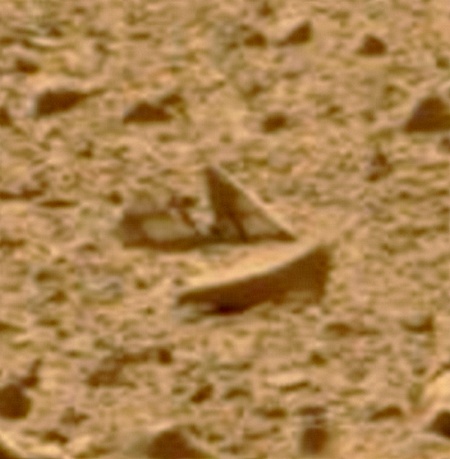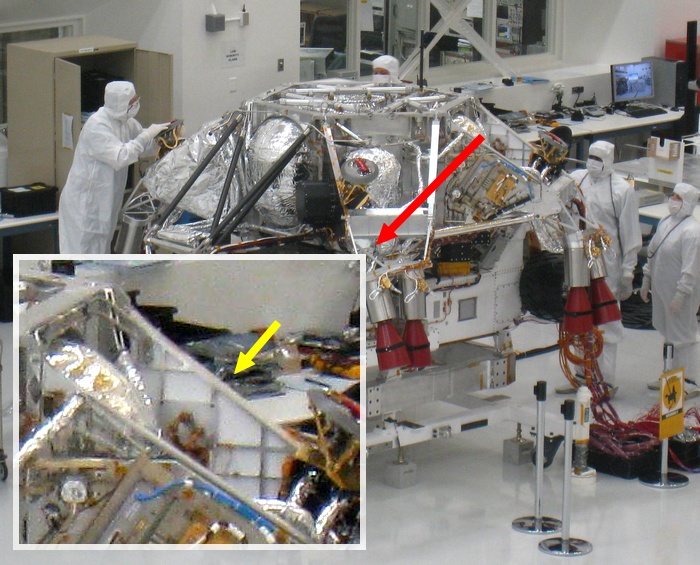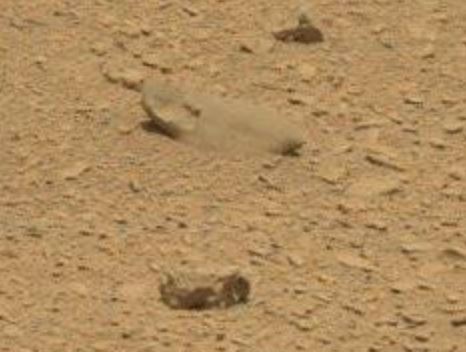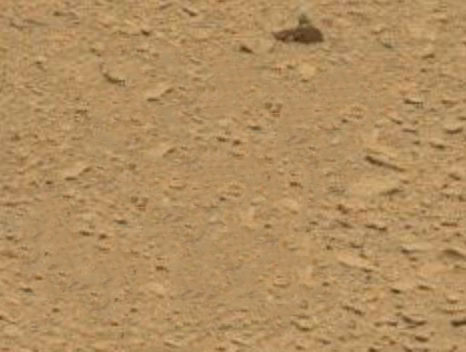It looks like you're using an Ad Blocker.
Please white-list or disable AboveTopSecret.com in your ad-blocking tool.
Thank you.
Some features of ATS will be disabled while you continue to use an ad-blocker.
share:
honestly, unless they drive the rover over there and drill it... i'll still go with the simpliest answer its rocks
i firmly believe if anything was in the pics it would be obvious, not a blobsquatch
but then they wouldnt release those pics now would they
i firmly believe if anything was in the pics it would be obvious, not a blobsquatch
but then they wouldnt release those pics now would they
reply to post by ArMaP
Content aware fill is a bad choice....it only clones parts of the surroundings.
I've seen the manipulation immediately.

Content aware fill is a bad choice....it only clones parts of the surroundings.
I've seen the manipulation immediately.

Yes, I would take a closer look. I also believe JPL took closer looks and better pictures. I do not believe for one second they allow us to see all
the pictures taken.
I see what you see!
Take a look at the pic titled "the triangle", look at the object just in front of it. Now add the triangle to the top of it and you have a sailboat.
I love looking at these pictures!
I see what you see!
Take a look at the pic titled "the triangle", look at the object just in front of it. Now add the triangle to the top of it and you have a sailboat.
I love looking at these pictures!
Originally posted by ArMaP
Originally posted by jeep3r
Now, imagine you were in command of Curiosity's every move, as part of the science team at JPL. Please look closely at those images again and ask yourself: would you decide to make Curiosity investigate one or more of these 'rocks' more in detail? Would you want to acquire close-up MAHLI images (or much better MastCam-views) of any of those features? If yes, which ones would justify a closer look and why? If no, what's the reason for not checking them in detail?
That depends, if I didn't had anything else to do may I would move Curiosity to study those rocks, but if I had a mission to accomplish and I didn't know if I had the time to do it I wouldn't bother with those rocks.
PS: as you noticed, the colour tags do not like 'apostrophes'.
My sentiments exactly- I could not possibly begin to give any hypothetical reasons as to why I'd say "no" to examining said rocks further, since I am not in the position of those controlling it, and I would have no idea what missions they need to accomplish and what time constraints they may be under. Having said that, I'm not so sure I see anything out of the ordinary with those pictures of rocks that you posted.....if you want to see fossils, cauldrons, etc, then that's exactly what you will see.
Originally posted by grobi77
reply to post by ArMaP
Content aware fill is a bad choice....it only clones parts of the surroundings.
I've seen the manipulation immediately.
Great FIND!
Why NASA/JPL use photoshop in raw images?
reply to post by jeep3r
Thank you for the Post! My only question is: Why don't Nasa drive up to some of these anomalies, like this one,
Skull lower left: marsrover.nasa.gov...
Thank you for the Post! My only question is: Why don't Nasa drive up to some of these anomalies, like this one,
Skull lower left: marsrover.nasa.gov...
Originally posted by ArMaP
Originally posted by jeep3r
Now, imagine you were in command of Curiosity's every move, as part of the science team at JPL. Please look closely at those images again and ask yourself: would you decide to make Curiosity investigate one or more of these 'rocks' more in detail? Would you want to acquire close-up MAHLI images (or much better MastCam-views) of any of those features? If yes, which ones would justify a closer look and why? If no, what's the reason for not checking them in detail?
That depends, if I didn't had anything else to do may I would move Curiosity to study those rocks, but if I had a mission to accomplish and I didn't know if I had the time to do it I wouldn't bother with those rocks.
PS: as you noticed, the colour tags do not like 'apostrophes'.
Hi ya mate, long time no speak! how is everything going? all i need now is JKROG.... shame about him, he is sorely missed! R.I.P. JKROG my friend!
Does anyone remember the Mars Pathfinder mission from back in the '90s?
It might be worth comparing some of them to see if anything looks "odd". If what wikipedia says is true, it only had a .3 mexapixel camera back then.
It might be worth comparing some of them to see if anything looks "odd". If what wikipedia says is true, it only had a .3 mexapixel camera back then.
A better question to ask isn't whether or not they are rocks or fossils, but where were the photos taken? Is there any proof that the photos really
came from Mars or is everyone just taking NASA's word for it? My personal opinion is that NASA doesn't have a need to study the rock formations
because a service technician can look them over when he goes out to that remote desert location in the Sahara, Death Valley, or possibly any other
desert on Earth to do maintenance work on the Rover. It's not like NASA has a good track record for being honest, so it's not that far fetched for
me to believe that they can take photos from a desert location on Earth, alter the color a bit, and sell it to the public as a means to keep the
Federal funds flowing for their "research".
Why do I feel like if I strapped my iPhone 4s to that rover it would take higher quality pictures?
I've just been looking at some photos from Viking 2 and other missions ... the quality doesn't seem to have improved much over the years. Odd.
I learned something new about Mars and the old Viking 2 mission back in the 70's:
Wikipedia
So, apparently even back in 70's we knew Mars had water. I don't know why they've been making a big deal out of recent, "water on Mars!!" annoucments. I guess liquid water is a bigger deal, but still....
Looking at all the experiments the Viking missions did, I can't help but wonder why we are still sending probes and not people to Mars. We've already analyzed the air and soil. We have an orbiter that has mapped the surface. We've determined the kinds of rocks Mars has. We know Mars has water.
Why are we still sending probes (that move at a snail's pace) and basically repeat the same experiments we've already carried out?! We could have used that money over the decades to send PEOPLE to Mars! SMH...
Maybe we're not supposed to go to Mars yet. I'd go in a heartbeat.
I've just been looking at some photos from Viking 2 and other missions ... the quality doesn't seem to have improved much over the years. Odd.
I learned something new about Mars and the old Viking 2 mission back in the 70's:
These minerals are typical weathering products of mafic igneous rocks.[4] All samples heated in the gas chromatograph-mass spectrometer (GSMS0] gave off water. However, the way the samples were handled prohibited an exact measurement of the amount of water. But, it was around 1%.[5
Wikipedia
So, apparently even back in 70's we knew Mars had water. I don't know why they've been making a big deal out of recent, "water on Mars!!" annoucments. I guess liquid water is a bigger deal, but still....
Looking at all the experiments the Viking missions did, I can't help but wonder why we are still sending probes and not people to Mars. We've already analyzed the air and soil. We have an orbiter that has mapped the surface. We've determined the kinds of rocks Mars has. We know Mars has water.
Why are we still sending probes (that move at a snail's pace) and basically repeat the same experiments we've already carried out?! We could have used that money over the decades to send PEOPLE to Mars! SMH...
Maybe we're not supposed to go to Mars yet. I'd go in a heartbeat.
Originally posted by ArMaP
Originally posted by Arken
Not so sure... "eraser tool" work at full power in NASA/JPL laboratories.
Content aware fill at full power in ArMaP's room.
It took me 10 minutes to do it, 5 of those minutes was the time I took to find out how to do it.
Thanks for this ArMaP!
Imagine what NASA/JPL they can do before the public relase and before the clearance of National Reconnaissance Office....
edit on
5-3-2013 by Arken because: (no reason given)
Originally posted by jeep3r
THE EXPERIMENT
Below you will find a selection of images that apparently show rocks or rock formations that are (in some way) quite different from their surroundings. They have been debated in several posts and threads, because of their distinct nature. Now, imagine you were in command of Curiosity's every move, as part of the science team at JPL. Please look closely at those images again and ask yourself: would you decide to make Curiosity investigate one or more of these 'rocks' more in detail? Would you want to acquire close-up MAHLI images (or much better MastCam-views) of any of those features? If yes, which ones would justify a closer look and why? If no, what's the reason for not checking them in detail?
I see where you are coming from. I'm not sure I agree these supposed rocks warrant further study, but let's put that aside for a moment, and ask what could cause an operator to NOT acquire close-up MAHLI images of interesting features, when so many uninteresting images are taken.
(really I think there is no such thing as an uninteresting image or feature from another planet)
Well, I think the answer might be something as simple as the operator(s) not noticing. Look at the threads here and see how often members aren't sure, what they are supposed to see, even though they are told something noteworthy positively is in the images - and then imagine an operator preoccupied with, well, operating, and how little attention he allocates 'random rocks'.
I bet Curiosity often is long gone before anyone on the team notices features like those posted here.
Also, it's not at all out of the question, that some of the close-ups we do have, DID initially look interesting and was taken exactly for that reason (..following the reasoning in the thought-experiment perfectly.)
Originally posted by grobi77
Content aware fill is a bad choice....it only clones parts of the surroundings.
I know, but if I, that did not even know how to use the content aware fill, could do this in 10 minutes on my lunch break, does anyone really think that a professional, doing only this type of work, couldn't do better?
PS: the 5 minutes it took me was mostly to try to avoid obvious clone marks, you should have seen how it looked at first. If I had the time I would have taken parts of other images close to that so it would only noticeable on a mosaic, then I could say that it was a side effect of the mosaic.
Originally posted by Arken
Great FIND!
Why NASA/JPL use photoshop in raw images?
You do understand that it was I (or is it "it was me"?) who used Photoshop to change the photo you posted, right?
Originally posted by DevineWisdom
Is there any proof that the photos really came from Mars or is everyone just taking NASA's word for it?
Proof? Not really, but the characteristics of the rocks and dust we see on the photos are different from what we can see on Earth, although the general look of Mars (in the areas where the rovers have landed) is very similar to some Earths' deserts.
The clouds we sometimes see are also different from the clouds we see on Earth, specially on the deserts that look like Mars.
In conclusion, I don't see anything that makes me think that these photos were taken on Earth.
Originally posted by DupontDeux
Originally posted by jeep3r
THE EXPERIMENT
Below you will find a selection of images that apparently show rocks or rock formations that are (in some way) quite different from their surroundings. They have been debated in several posts and threads, because of their distinct nature. Now, imagine you were in command of Curiosity's every move, as part of the science team at JPL. Please look closely at those images again and ask yourself: would you decide to make Curiosity investigate one or more of these 'rocks' more in detail? Would you want to acquire close-up MAHLI images (or much better MastCam-views) of any of those features? If yes, which ones would justify a closer look and why? If no, what's the reason for not checking them in detail?
I see where you are coming from. I'm not sure I agree these supposed rocks warrant further study, but let's put that aside for a moment, and ask what could cause an operator to NOT acquire close-up MAHLI images of interesting features, when so many uninteresting images are taken.
(really I think there is no such thing as an uninteresting image or feature from another planet)
Well, I think the answer might be something as simple as the operator(s) not noticing. Look at the threads here and see how often members aren't sure, what they are supposed to see, even though they are told something noteworthy positively is in the images - and then imagine an operator preoccupied with, well, operating, and how little attention he allocates 'random rocks'.
I bet Curiosity often is long gone before anyone on the team notices features like those posted here.
Also, it's not at all out of the question, that some of the close-ups we do have, DID initially look interesting and was taken exactly for that reason (..following the reasoning in the thought-experiment perfectly.)
I agree.... If someone is sitting there watching all the footage he's probably so tired of looking at rocks that everything just starts looking the same.
I know there are "interesting" rock formations, but what may be interesting to us is probably not as interesting to a geologist. I remember when I was a kid, we'd find rocks and think they were a little shiny so they probably had gold in them or they looked like they could have been an arrowhead or spear head or something. Those are the eyes that we're using to look at these images. They're probably perfectly normal formations, but we see an arrowhead or a fossil or a sailboat or something.
I can't imagine wanting to cover up genuine artifacts on mars. Can you imagine the amount of funding and public support they'd get if they uncovered alien artifacts?
Originally posted by kaidec
Yes, I would take a closer look. I also believe JPL took closer looks and better pictures. I do not believe for one second they allow us to see all the pictures taken. I see what you see! Take a look at the pic titled "the triangle", look at the object just in front of it. Now add the triangle to the top of it and you have a sailboat.
I love looking at these pictures!
Thanks, Kaidec. I've actually been looking long and intensively at the picture with the "triangle". In comparison with the other rocks around, it just seemed to be a bit 'too perfect' with almost no effects of erosion whatsoever.
Eventually, I took a look at some early pics of Curiosity during its construction phase and came to the conclusion that we might be looking at a part of the descent stage that was blown away upon impact after MSL landed.
But compare for yourself:


If that's what it is, I still find it strange that NASA doesn't want to take a closer look especially when they're so close by in that area. And, interestingly, this would also demonstrate just how martian wheathering and dust affects parts or debris that are rather new or 'fresh'. It seems indistinguishable (in terms of colors) from the rest of the surface features.
If it's really part of the descent stage, then we'd have to admit the truth and dismiss this particular 'artifact' as something native to Mars. However, it still wouldn't explain away all the other intriguing things we see at Rocknest.
edit on 5-3-2013 by jeep3r because: text
Originally posted by DupontDeux
Well, I think the answer might be something as simple as the operator(s) not noticing. Look at the threads here and see how often members aren't sure, what they are supposed to see, even though they are told something noteworthy positively is in the images - and then imagine an operator preoccupied with, well, operating, and how little attention he allocates 'random rocks'.
Thanks for your input, DupontDeux!
Actually, after having gained my first experiences with that sceptical "it's just a rock" crowd, I also started asking myself whether or not there are in fact several kinds of 'observers' or forum participants, namely:
a) those seeing something very clearly, so intriguing & dominant, they gotta talk about it
b) those who 'really' don't see anything, even if they try hard to find it
c) those who are just sceptical (even if they see something very unusual, they'd deny it)
c) those who always post 'it's just a rock' (even if you posted a clear pic of an alien)
d) those who make fun of people spending their time investigating unique Mars images
e) those who are sceptical but actually 'try' to see what you see
etc. etc. etc.
But I honestly think, there must be quite a few who are really interested (in principle) but just don't recognize anything out-of-the-ordinary. And with that bunch, we have a really hard time convincing them (if that's possible at all)
Just some thoughts ...
Originally posted by MystikMushroom
Why do I feel like if I strapped my iPhone 4s to that rover it would take higher quality pictures?
Because you don't know what you're talking about?
I've just been looking at some photos from Viking 2 and other missions ... the quality doesn't seem to have improved much over the years. Odd.
The Viking photores are 6 bits per pixel, with a maximum vertical resolution of 500 pixels, Opportunity and Spirit have a 8 bits per pixel monochromatic camera with a 1024 x 1024 resolution, while Curiosity's Mastcam has 24 bits per pixel colour camera with a 1200 x 1200 resolution (and bigger lens). Viking's camera had a best spatial resolution at 3 metres of 2.1 mm/pixel, Opportunity and Spirit a 0.8 mm/pixel (Pancam) and Curiosity's Mastcams have 1.25 and 3.67 times higher resolution than the older rovers' Pancam.
So, apparently even back in 70's we knew Mars had water. I don't know why they've been making a big deal out of recent, "water on Mars!!" annoucments. I guess liquid water is a bigger deal, but still....
Some water in the rocks is expected.
We know Mars has water.
Where?
Why are we still sending probes (that move at a snail's pace) and basically repeat the same experiments we've already carried out?! We could have used that money over the decades to send PEOPLE to Mars! SMH...
A manned mission is also very expensive, even if they hadn't to carry all that automated equipment, as humans need to carry oxygen and food for the time they are on Mars and for the (long) journey, so a bigger craft is needed.
And they are not repeating the same experiments.
new topics
-
Former Labour minister Frank Field dies aged 81
People: 21 minutes ago -
SETI chief says US has no evidence for alien technology. 'And we never have'
Aliens and UFOs: 2 hours ago -
This is our Story
General Entertainment: 4 hours ago -
President BIDEN Vows to Make Americans Pay More Federal Taxes in 2025 - Political Suicide.
2024 Elections: 6 hours ago -
Ode to Artemis
General Chit Chat: 7 hours ago -
Ditching physical money
History: 11 hours ago -
One Flame Throwing Robot Dog for Christmas Please!
Weaponry: 11 hours ago -
Don't take advantage of people just because it seems easy it will backfire
Rant: 11 hours ago
top topics
-
University student disciplined after saying veganism is wrong and gender fluidity is stupid
Education and Media: 15 hours ago, 14 flags -
President BIDEN Vows to Make Americans Pay More Federal Taxes in 2025 - Political Suicide.
2024 Elections: 6 hours ago, 10 flags -
One Flame Throwing Robot Dog for Christmas Please!
Weaponry: 11 hours ago, 6 flags -
Should Biden Replace Harris With AOC On the 2024 Democrat Ticket?
2024 Elections: 13 hours ago, 6 flags -
Don't take advantage of people just because it seems easy it will backfire
Rant: 11 hours ago, 4 flags -
Ditching physical money
History: 11 hours ago, 4 flags -
SETI chief says US has no evidence for alien technology. 'And we never have'
Aliens and UFOs: 2 hours ago, 3 flags -
God lived as a Devil Dog.
Short Stories: 16 hours ago, 3 flags -
Ode to Artemis
General Chit Chat: 7 hours ago, 2 flags -
VirginOfGrand says hello
Introductions: 12 hours ago, 2 flags
active topics
-
Former Labour minister Frank Field dies aged 81
People • 2 • : Freeborn -
Terrifying Encounters With The Black Eyed Kids
Paranormal Studies • 72 • : Consvoli -
The Superstition of Full Moons Filling Hospitals Turns Out To Be True!
Medical Issues & Conspiracies • 24 • : angelchemuel -
SETI chief says US has no evidence for alien technology. 'And we never have'
Aliens and UFOs • 13 • : andy06shake -
"We're All Hamas" Heard at Columbia University Protests
Social Issues and Civil Unrest • 266 • : KrustyKrab -
Russia Ukraine Update Thread - part 3
World War Three • 5720 • : Freeborn -
University student disciplined after saying veganism is wrong and gender fluidity is stupid
Education and Media • 32 • : BedevereTheWise -
So this is what Hamas considers 'freedom fighting' ...
War On Terrorism • 227 • : HopeForTheFuture -
Remember These Attacks When President Trump 2.0 Retribution-Justice Commences.
2024 Elections • 51 • : Justoneman -
British TV Presenter Refuses To Use Guest's Preferred Pronouns
Education and Media • 131 • : FlyersFan


